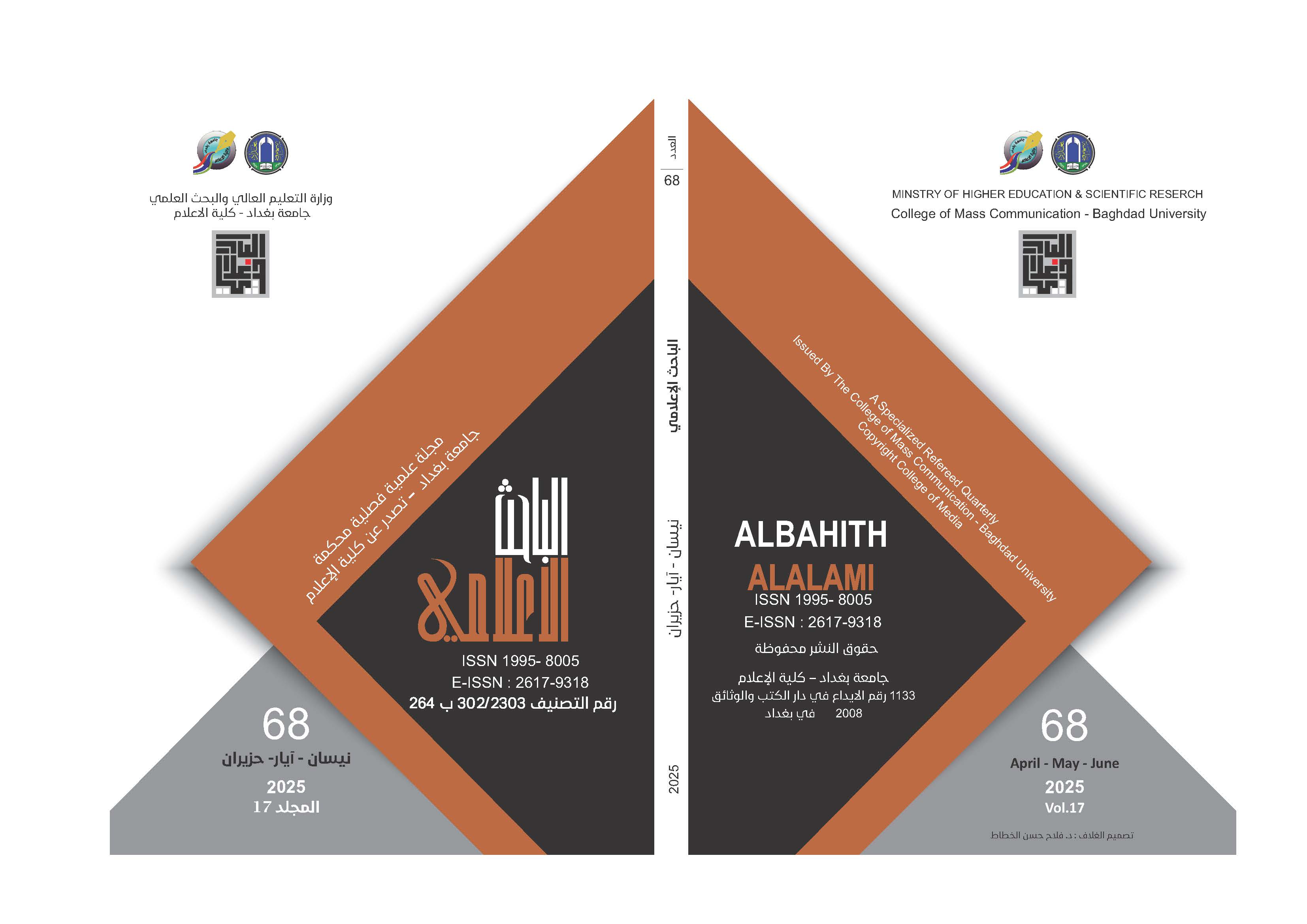Cultural Dimensions in Television Advertising
A Semiotic Study
DOI:
https://doi.org/10.33282/abaa.v17i68.1274Keywords:
Cultural Dimensions, Advertising, Cultural Analysis, Semiotics, HofstedeAbstract
Objectives: This research aimed to highlight the semiotic approach in analyzing television advertising, to uncover the hidden and indirect meanings behind the apparent message of the advertisement "Zain Ya Baghdad" through semiotic analysis. It also incorporated cultural analysis using Hofstede's cultural dimensions, to reveal the relationship between text and image and understand the factors influencing the semiotics of the image, given that it contains signs, symbols, rules, and meanings rooted in the prevailing social and intellectual conditions of society.
Methodology: The research stages were conducted by deconstructing the advertisement scenes into individual shots and analyzing them, then reconstructing them to uncover hidden aspects, based on the semiotic analysis approach.
Results: The results showed the dominance of the cultural dimension in the content of the advertisement, which was not merely a direct commercial promotion but was laden with cultural and heritage meanings. Elements of Iraqi identity such as music, locations, characters, language, and clothing were employed to deliver an emotional message about Baghdad. Visual and iconic symbols served the cultural meaning by incorporating traditional professions like coppersmithing and calligraphy, and famous locations such as Al-Mutanabbi Street and traditional cafés, enabling the advertisement to present Baghdad as a unifying cultural and emotional symbol. Additionally, the analysis revealed inconsistencies with some of Hofstede's indicators for Iraq, showing clear discrepancies between the global Hofstede classification and the culture reflected in the advertisement.
Conclusions: Television advertising is no longer merely a promotional tool but has become a medium for constructing cultural symbols and reinforcing collective identity. The study reveals that cultural values in Iraqi society, as represented in the advertisement, partially differ from Hofstede's indicators, reflecting unique local cultural characteristics.
Downloads
References
Al-Azzawi, M. M., & Jameel, B. (2021). The Semiology of Narrative Construction in Television Advertising to an Announce "God Will not Forget us" about the Covid-19 Pandemic for Zain Mobile Telecommunication Company. ALBAHITH ALALAMI, 13(52), 223-240. https://doi.org/10.33282/abaa.v13i52.776
Al-Jamal, R. M. (2009). International Public Relations and Intercultural Communication. Cairo: Egyptian-Lebanese Publishing House.
Al-Rajhi, A. (1998). Grammatical Application. Cairo: Dar Al-Maaref Al-Jamiiyya.
Alazawi, M., & Alrawi, B. (2022). Denotation of Narrative Features in Television Advertising (A Semiotic Approach to Mr. President's Declaration). Dirasat: Human and Social Sciences, 49(1), 144-171. https://doi.org/10.35516/hum.v49i1.1651
Aumont, J., & Marie, M. (2004). analyse des films. paris: Broché.
Borrelli, N. (2007). Advertising Across Cultures: A Linguistic-Semiotic Analysis of British and Italian TV Commercials [Doctoral thesis, Università degli Studi di Napoli Federico II]. http://doi.org/10.6092/UNINA/FEDOA/1811
Bouchehit, M. (2016). The method of 'film analysis' from theory to practice: How do we read a film according to the film reading framework? Journal of Communication and Journalism, 3(2), 86-118. https://asjp.cerist.dz/en/article/35622
Cathetat, B. (2001). Publicite et societe. Paris: Payot.
de Mooij, M., & Hofstede, G. (2010). The Hofstede model: Applications to global branding and advertising strategy and research. International Journal of Advertising, 29(1), 85-110. https://doi.org/10.2501/S026504870920104X
Eco, U. (2007). The Sign: An Analysis of the Concept and Its History (S. Bengrad, Trans.). Beirut: Arab Cultural Center.
Fethi, K. M. (2017). Cultural Representations in Television Advertising: An Analytical Study of a Sample of Advertisements on the Private Channel Echorouk TV. [Doctoral Thesis, University of Abdelhamid Ibn Badis, Mostaganem]. http://e-biblio.univ-mosta.dz/handle/123456789/871
Hofstede, G. (2011). Dimensionalizing Cultures: The Hofstede Model in Context. Online Readings in Psychology and Culture, 2(1). https://doi.org/10.9707/2307-0919.1014
Hofstede’s Insights. (n.d). Design a culture that will support your strategy. Hofstede Insights. https://www.hofstede-insights.com/country/iraq/
Ismail, M. H. E. (2014). Satirists and Rebels: Semiotic and Cultural Studies in Arab Media. Cairo: Al Arabi For Publishing and Distribution.
Mokrétar, k., & Al-Arabi, B. (2016). The Cultural Representqtion In Advertising Discours (The Advertising Of Ennahar TV). Jamaliyat, 3(3), 64-72. https://asjp.cerist.dz/en/article/77246
Muhanna, F. (2002). Communication Sciences and Digital Communities. Beirut: Dar Al-Fikr Al-Muasir.
Salima, S., & Bakhoush, N. (2015). Rhetorical Methods in Television Advertising: A Semiological Study on a Sample of Advertising Flashes in Algerian Television [Master's Thesis, Mohamed Khider University of Biskra]. http://archives.univ-biskra.dz/handle/123456789/6746
Downloads
Key Dates
Received
Revised
Accepted
Published
Issue
Section
License
Copyright (c) 2025 Author

This work is licensed under a Creative Commons Attribution 4.0 International License.
Authors retain copyright and grant the journal right of first publication with the work simultaneously licensed under a Creative Commons Attribution License (CC BY 4.0) that allows sharing the work with recognition of authorship and initial publication in ABBA journal.


















